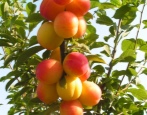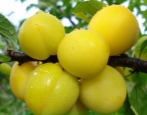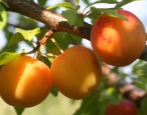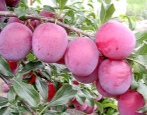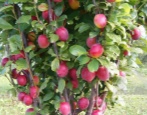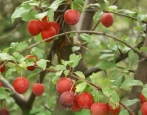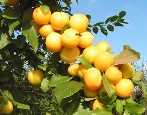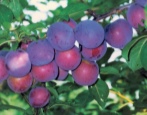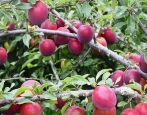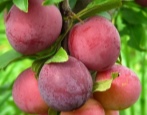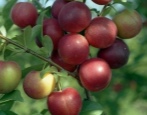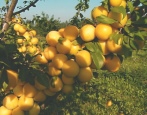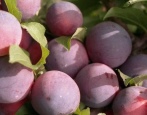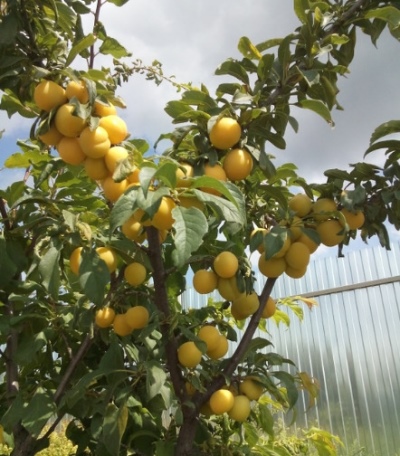
- Authors: Timiryazev Agricultural Academy
- Growth type: medium-sized
- Self-fertility: partially self-fertile
- Fruit size: small
- Yield: high
- Appointment: for fresh consumption
- Transportability: good
- Marketability: high
- Fruit weight, g: up to 20
- Fruit color: yellow
You can grow a tree with tasty fruits, while decorating the garden, by picking up an unpretentious fruit type, for example, cherry plum. One of the popular varieties is Tsarskaya, representing domestic selection.
Breeding history
Cherry plum Tsarskaya appeared as a result of the painstaking work of Russian breeders of the Moscow Agricultural Academy named after I. K. A. Timiryazeva. The culture was bred by the method of free pollination using the Kubanskaya comet variety.
Description of the variety
Tsarskaya is a medium-sized tree with a semi-circular crown shape, moderate spreading of branches and a slight thickening of light green leaves. In favorable conditions cherry plum grows up to 2.5, sometimes up to 3 meters in height, and up to 150 cm in diameter. A characteristic feature of the culture is a stem of a dark gray-brown color, massively covered with small cracks and lenticels.
During the flowering period (late April - early May), the crown of the tree is simply covered with large snow-white flowers with smooth petals and a bright fragrant aroma. Thanks to late flowering, the tree avoids recurrent frosts.
Fruit characteristics
Cherry plum Tsarskaya is a group of medium-fruited species. On a healthy tree, fruits gain weight up to 20 grams. The shape of the cherry plum is perfectly correct - spherical with a smooth glossy surface, where a light waxy coating is noticeable. The fruits are one-dimensional, therefore the variety has high commercial qualities. The skin of the cherry plum is dense, non-rigid, with a weakly pronounced abdominal suture. Ripe fruits are evenly colored bright yellow.
Cherry plum has a universal purpose - the fruits are eaten fresh, are widely used in cooking, for example, for sauces, processed into jams, preserves, compotes, canned whole and dried. In addition, the harvested cherry plum can be transported over long distances, as well as stored for one month.
Taste qualities
The name of the variety says a lot. Cherry plum is characterized by a harmonious taste that resembles a mixture of melon and apricot. The taste is dominated by a balance of sweetness and acidity, complemented by a pleasant fruity aroma. The pale yellow flesh is endowed with a firm, fleshy, tender and slightly fibrous structure with strong juiciness. The fruit stone is small, easily separating from the pulp. There are no tannins in the cherry plum pulp, but fructose and citric acid are present in large quantities.
Ripening and fruiting
Cherry plum Tsarskaya can boast of early maturity - the first harvest is observed in the 2nd year after planting the seedling. You can taste the first fruits at the end of July. Mass fruiting occurs in early August. Fruits are not spiced at the same time. The tree bears fruit stably - annually. The fruiting period stretches for a whole month.
Yield
The yield indicators of cherry plum are excellent. With proper agricultural technology, 20-25 kg of delicious cherry plum can be harvested from one tree.
Self-fertility and the need for pollinators
Cherry plum Tsarskaya is partially self-fertile, therefore it needs pollinating trees. Donor trees, the flowering times of which coincide with the flowering times of the Tsar's cherry plum, are planted at a distance of 2 to 5 meters. The following varieties are productive pollinators - Pramen, Cleopatra, Traveler, Nayden and Kuban comet.
Growing and care
Cherry plum seedlings are planted in March-April.For this, one / two-year-old seedlings with a developed root system, endowed with 5-6 shoots 25-30 cm long, are suitable. It is uncomfortable for a tree to grow in the neighborhood of an apple tree, cherry, walnut, pear and sweet cherry.
Agricultural technology of fruit and ornamental crops includes a number of standard measures - regular watering, since cherry plum is moisture-loving, the introduction of organic and mineral fertilizers three times during the growing season, loosening and mulching of the soil, sanitary pruning of branches, crown formation, thinning of branching and other growth, prevention of diseases and insect invasions ...
Winding the trunk with nylon will help protect the tree from rodents for the winter. As protection from the cold - deep mulching using spruce branches or straw, as well as wrapping the trunk with burlap or other suitable material.
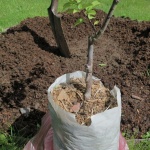
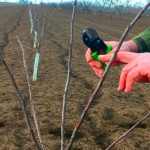
Disease and pest resistance
This fruit crop is resistant to many diseases, fungi and insects. Very rarely Tsarskaya cherry plum is affected by powdery mildew, clotterosporia, rust and moniliosis. Regarding the pests that are attracted by cherry plum, it is worth noting the down silkworm, sawfly, tolstopod and moth. Preventive treatments with insecticides and fungicides will help protect the tree from diseases and insect attacks.

Requirements for soil and climatic conditions
An ideal place for the growth of Tsar's cherry plum will be a flat area with fertile, moist, loose and breathable soil with low or neutral acidity - light loams. The passage of groundwater must be deep, since stagnant moisture can lead to rotting of the root system of the tree. It is better to choose a place in the south-western part of the garden, where there is protection from the cold wind.
Due to its resistance to stress, the fruit-ornamental tree easily survives a sharp drop in temperature to -30 degrees. In addition, the tree is not afraid of heat and partial shade. Long-term drought, drafts and dampness negatively affect the development of culture.
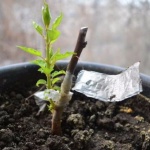
Review overview
Cherry plum Tsarskaya is a very popular variety among amateur summer residents and farmers who grow fruits on an industrial scale. This is due to the fact that the culture is not capricious in its care, quickly adapts to growing conditions, bears fruit stably, giving tasty and juicy fruits. Many housewives are captivated by the versatility of the fruit, as well as the valuable composition of the pulp, filled with useful vitamins. Among the shortcomings of culture, it is worth noting only the need for frequent thinning of branches and removal of overgrowth.

